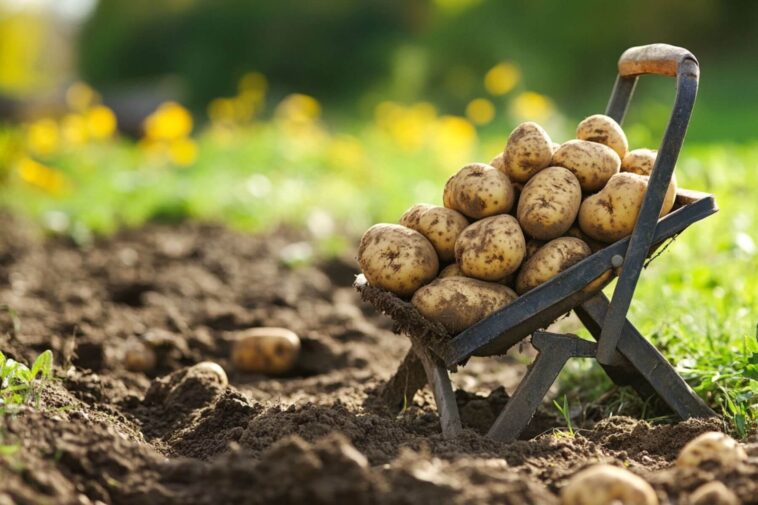It’s been a busy week here on the homestead, and we’re making the most of the warm fall weather by getting next year’s potato crop in the ground. There are several advantages to planting potatoes in the fall, and it’s a method we’ve come to appreciate.
Years ago, an older farmer shared some advice with us. He mentioned that, back in his day, they always planted potatoes, garlic, and onions in the fall. His words stuck with us, prompting us to rethink how and when we plant our potatoes.
Potatoes are incredibly hardy. Every year, volunteer potato plants pop up in our garden, and they thrive even without us planting them. So why should we wait until spring—when we’re swamped with other garden chores—to plant potatoes?
Why Plant Potatoes in the Fall?
1. A Head Start for Potatoes
Potatoes planted in the fall benefit from an early start to the growing season. Over the winter, they remain dormant in the soil, and as soon as the soil warms up in spring, they begin to grow.
Although you may not see the sprouts immediately, the potatoes will be busy growing roots beneath the surface. Planting them in the fall allows this root development to begin as soon as the soil conditions are right, giving your crop a two-week advantage over spring-planted potatoes.
2. Weather Won’t Delay Planting
In our zone 5b area, spring weather can be unpredictable. Heavy rains or even snowstorms in April or May often delay planting. If you don’t use a deep mulch system in your garden, a rainstorm can leave the soil too wet to work with for days or even weeks.
Even with mulch methods like “Back to Eden” or Ruth Stout’s system, you still need decent weather to get into the garden. By planting in the fall, you avoid these springtime weather delays. Instead of holding up planting, spring rains will help your potatoes grow, giving them a strong start.
3. Earlier Harvests
Because fall-planted potatoes get an earlier start, they grow faster, leading to an earlier harvest compared to those planted in spring.
Once you’ve harvested your first round of potatoes, you can plant a second crop of early-maturing varieties, allowing for two potato harvests in a single growing season.
4. No Bug Swarms to Deal With
If you’ve ever planted potatoes in the spring, you’ll know what I mean by this. Springtime in many regions coincides with the emergence of swarms of blackflies and mosquitoes. It’s not exactly pleasant to work in the garden while being eaten alive by bugs!
Planting potatoes in the fall is a much more peaceful experience—no bugs to contend with while you work.
How to Plant Potatoes in the Fall
When it comes to fall planting, your first task is to gather your seed potatoes. In early spring, seed potatoes are easy to find in garden centers, but come fall, especially in northern areas, they may be harder to come by. This means you’ll likely need to save seed potatoes from your own summer harvest.
Unlike in the spring, where potatoes are often cut into smaller pieces to stretch your supply of seed potatoes, it’s best to plant whole potatoes in the fall. Potatoes that have been cut are more susceptible to rotting over the winter, while whole tubers are better equipped to remain dormant until spring.
Choose firm seed potatoes that show no signs of disease, such as blight, scab, or rot. Ideally, they should be around the size of a golf ball or larger.
There’s some flexibility here. While larger seed potatoes provide more initial energy to the plant, many gardeners prefer to save the bigger tubers for eating and use the smaller ones for planting. Egg-sized potatoes work just fine, but larger ones tend to result in slightly better yields and stronger plants.
Next, prepare your planting area. Since we use a deep mulch, no-till gardening approach, our process is simple. We use a homemade row maker to create our planting rows, though you could just as easily use a string line to mark them.
The rows should be deep enough that the mulch is pushed aside, revealing bare soil.
Place the seed potatoes in the furrows, spacing them about 6 to 8 inches apart.
After planting, we cover the potatoes with 1 to 2 inches of rabbit manure mixed with composted wood chips. This combination slowly releases nutrients into the soil over the winter, feeding the plants as they grow.
To finish, we add a final layer of 4 inches of wood chip mulch. This helps protect the potatoes from winter frost and cold temperatures.
Give Fall Potato Planting a Try
Why not lighten your load in the busy spring season and get your potatoes planted this fall? They’ll have a great head start when the warm weather returns, and you won’t need to rush to get them in the ground during the hectic spring planting time.


